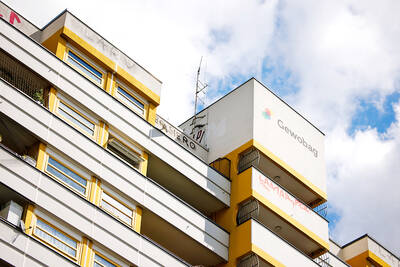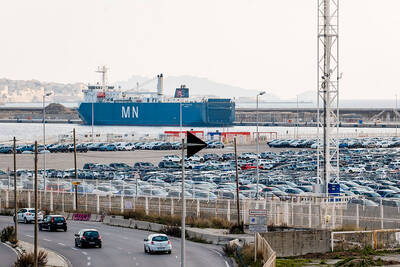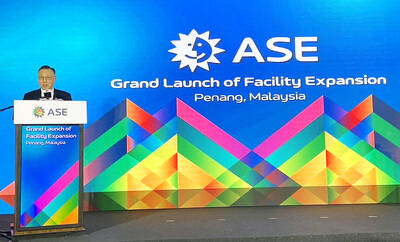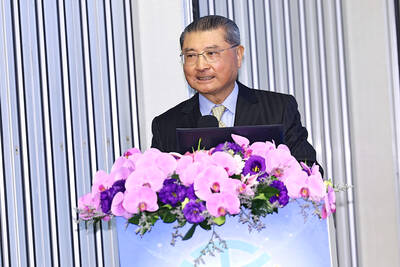The enemy is nearly invisible and there are no soldiers, but the Indian capital’s new “Green War Room” is battling air pollution that is cutting lives of residents by more than a decade.
“It’s a pollution emergency,” said Gopal Rai, minister for environment, forest and wildlife, development and general administration for the rapidly expanding megacity of more than 20 million people, consistently ranked the world’s worst capital for air quality.
Rai dubs the problem an “air-pocalypse.”

Photo: AFP
New Delhi’s latest effort to combat a decades-old problem is a high-tech coordination center, where 17 experts monitor giant screens livestreaming pollution hotspots, beaming in NASA satellite imagery and updating air quality index (AQI) sensors.
In Delhi, levels of PM2.5 pollutants — cancer-causing microparticles that enter the bloodstream through the lungs — often hit more than 30 times WHO danger limits.
On Friday, schools were shut across the city as a noxious gray smog engulfed it, making life a misery for its 30 million inhabitants.
The average city resident could die nearly 12 years earlier due to air pollution, an August report by the University of Chicago’s Energy Policy Institute found.
Eye-stinging and lung-burning smog worsens during winter from October to February — when colder air traps pollution — and residents are advised to wear masks outside at all times.
Last month, Delhi opened the pollution coordination hub connecting 28 government departments — complete with “Green War Room” sign — to zoom in on exact emission sites.
“As soon as the AQI worsens, we alert our teams on the ground and they take action immediately,” the war room’s environmental engineer Anurag Pawar said.
A problem factory can be served a notice, a garbage fire put out, vehicles belching black smoke stopped, illegal firework displays for festivals halted or trucks spraying water sent to douse down dust.
However, the key problem remains out of their hands — the huge fires lit by farmers surrounding Delhi to clear rice fields after harvests for the sowing season.
Farm fires can cloak the city in a yellow-gray soupy smog that, one study in the Lancet medical journal said caused almost 17,500 premature deaths in 2019.
Air pollution is “one of the greatest environmental risks to health,” the WHO says, triggering strokes, heart disease, lung cancer and respiratory diseases.
To reduce that, Delhi authorities have begun using biochemical sprays that speed up decomposition of the crop stubble, to ready the soil for planting, but as with so many environmental efforts, good intentions hit political roadblocks.
Rai said the source of more than two-thirds of air pollution plaguing the city comes from beyond its borders, where municipal authorities do not have the authority to act.
“We have introduced electric buses, but in the adjoining states buses are still being run on diesel,” Rai said. “All that impacts Delhi. Pollution and winds can’t be restricted by state boundaries.”
Pollution has become a political flashpoint.
The capital and Punjab state are governed by the Aam Aadmi Party, but other neighboring states are led by their rivals from Indian Prime Minister Narendra Modi’s Bharatiya Janata Party.
Farmers, a powerful bloc of voters, say stubble burning is easy and cheap, and city pollution does not affect them.
“Obviously, the politics has an impact,” Rai said. “It creates hurdles when it comes to implementing policies.”
Tackling pollution aids the wider climate change battle and moves to protect public health, experts say.
The WHO says that “many drivers of air pollution are also sources of greenhouse gas emissions,” and that policies to reduce air pollution “offer a win-win strategy for both climate and health.”
War room officers say they are doing what they can — such as monitoring reports sent via a “Green Delhi” phone app, which allows residents to send geolocated photographs of pollution problems.
“Most of the complaints are about burning garbage dumps and dust from construction sites,” Pawar said. “Once we receive the complaint, we coordinate with various departments and make sure it is resolved quickly.”
However, Sunil Dahiya, an analyst with the Centre for Research on Energy and Clean Air, said that bigger policy changes are needed.
India is heavily reliant on polluting coal for energy generation. It has seen its per capita coal emissions rise 29 percent in the past seven years and has shied away from policies to phase down the dirty fossil fuel.
“The Green War Room, if done the right way, will be effective in suppressing the pollution for some time, but it is not the solution to cut down emissions,” Dahiya said. “When it comes to breathing clean air and reducing pollution levels, much more comprehensive and systematic changes are required.”

When an apartment comes up for rent in Germany’s big cities, hundreds of prospective tenants often queue down the street to view it, but the acute shortage of affordable housing is getting scant attention ahead of today’s snap general election. “Housing is one of the main problems for people, but nobody talks about it, nobody takes it seriously,” said Andreas Ibel, president of Build Europe, an association representing housing developers. Migration and the sluggish economy top the list of voters’ concerns, but analysts say housing policy fails to break through as returns on investment take time to register, making the

‘SILVER LINING’: Although the news caused TSMC to fall on the local market, an analyst said that as tariffs are not set to go into effect until April, there is still time for negotiations US President Donald Trump on Tuesday said that he would likely impose tariffs on semiconductor, automobile and pharmaceutical imports of about 25 percent, with an announcement coming as soon as April 2 in a move that would represent a dramatic widening of the US leader’s trade war. “I probably will tell you that on April 2, but it’ll be in the neighborhood of 25 percent,” Trump told reporters at his Mar-a-Lago club when asked about his plan for auto tariffs. Asked about similar levies on pharmaceutical drugs and semiconductors, the president said that “it’ll be 25 percent and higher, and it’ll

CHIP BOOM: Revenue for the semiconductor industry is set to reach US$1 trillion by 2032, opening up opportunities for the chip pacakging and testing company, it said ASE Technology Holding Co (日月光投控), the world’s largest provider of outsourced semiconductor assembly and test (OSAT) services, yesterday launched a new advanced manufacturing facility in Penang, Malaysia, aiming to meet growing demand for emerging technologies such as generative artificial intelligence (AI) applications. The US$300 million facility is a critical step in expanding ASE’s global footprint, offering an alternative for customers from the US, Europe, Japan, South Korea and China to assemble and test chips outside of Taiwan amid efforts to diversify supply chains. The plant, the company’s fifth in Malaysia, is part of a strategic expansion plan that would more than triple

Taiwanese artificial intelligence (AI) server makers are expected to make major investments in Texas in May after US President Donald Trump’s first 100 days in office and amid his rising tariff threats, Taiwan Electrical and Electronic Manufacturers’ Association (TEEMA, 台灣電子電機公會) chairman Richard Lee (李詩欽) said yesterday. The association led a delegation of seven AI server manufacturers to Washington, as well as the US states of California, Texas and New Mexico, to discuss land and tax issues, as Taiwanese firms speed up their production plans in the US with many of them seeing Texas as their top option for investment, Lee said. The